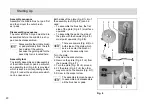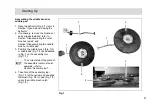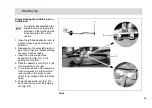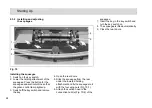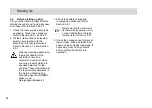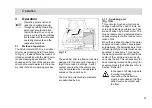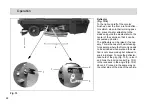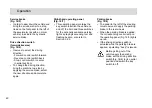
29
Operation
3.1.2 Squeegee
(Fig. 13/5)
The squeegee, which projects at the
sides, is fixed to the scrubber drier so
that it can pivot and swing. This enables
it to evade obstacles in the current track
and pivot back. Its strong suction ca-
pacity ensures the waste water is vacu-
umed up fully even on uneven floor and
in bends, leaving the floor dry enough to
be walked on. The squeegee must be
checked prior to starting work, when
disposing of waste water and/or filling
the solution tank and cleared of any for-
eign bodies which have been vacu-
umed up.
Check that the sealing strips are in per-
fect condition. The rollers serve to sup-
port the squeegee to prevent excessive
bending of the sealing strips. The
squeegee is automatically raised when
reversing.
3.1.3 Suction turbines (suction)
(Fig. 14/3)
The two suction turbines are located on
the rear panel of the solution tank and
can be accessed after opening the rear
doors. The suction turbines are
switched on and off automatically when
lowering and raising the squeegee, re-
spectively. A float switch in the recovery
tank switches the suction turbine off au-
tomatically on reaching the maximum
fill height.
3.1.4
Solution tank
The solution tank is located behind the
driver's seat, on the right-hand side
(when facing the front). The fresh water
tank is a tank partitioned by a mem-
brane panel and has a volume of ap-
prox. 296 liters. Open up the gray tank
cap and secure it to fill the tank. Fill wa-
ter, max. 50 °C, and add the cleaning
agent in accordance with the manufac-
turer's instructions. Lower the cap again
to close it.
Only use cleaning agents (non-
foaming) suitable for the
vehicle's vendor.
We recommend using our clean and
care products which are specially bal-
anced for the scrubber drier. These
products meet the requirements stipu-
lated in the German washing and clean-
ing agent directive (WRMG - Wasch-
und Reinigungsmittelgesetzes). Ob-
serve the correct dosage of the clean-
ing agent. The correct dosage helps to
reduce costs and protect the environ-
ment.
The development of excessive foam im-
pairs the machine's function. It indi-






